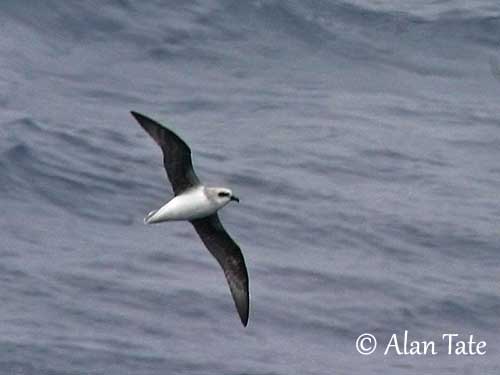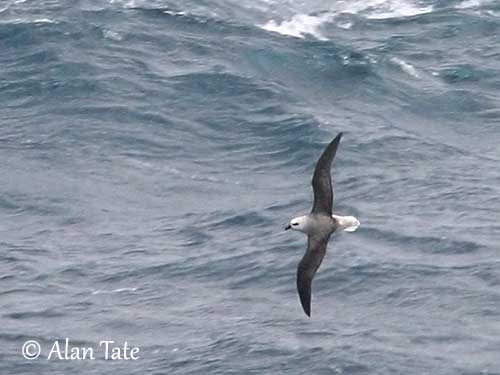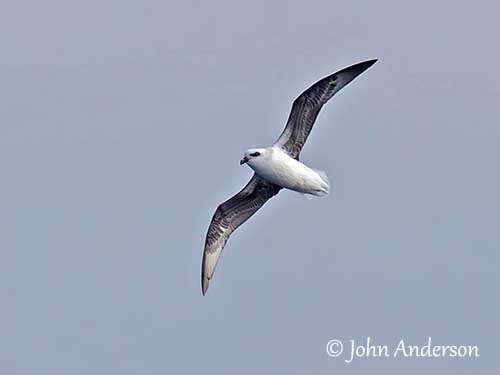
Fr: Pétrel de Lesson
All: Weißkopf-Sturmvogel
Esp: Petrel Cabeciblanco
Ita: Petrello testabianca
Nd: Witkopstormvogel
Sd: Vithuvad petrell
Photographers:
John Anderson
John Anderson Photo Galleries
Otto Plantema
Trips around the world
Alan & Ann Tate
AA Bird Photography
Text by Nicole Bouglouan
Sources:
HANDBOOK OF THE BIRDS OF THE WORLD vol 1 by Josep del Hoyo-Andrew Elliot-Jordi Sargatal - Lynx Edicions - ISBN: 8487334105
BirdLife International (BirdLife International)
New Zealand birds and birding (Narena Olliver)
White-headed Petrel
Pterodroma lessonii
Procellariiformes Order – Procellariidae Family
INTRODUCTION:
The White-headed Petrel is a member of Pterodroma genus which includes the seabirds known as “gadfly petrels”. This name is related to the high soaring flight at sea performed by these birds.
This species has distant feeding grounds and this flight allow it to travel long distances from land. It is strictly nocturnal when breeding, in order to avoid predation by the Brown Skua (Stercorarius antarcticus).
DESCRIPTION OF THE BIRD:
Biometrics:
Length: 40-46 cm
Wingspan: 109 cm
Weight: 580-800 g
The adult is grey and white. The upperparts are pale grey, with darker grey upperwing. Head, rump and tail are whitish.
The underparts are white, contrasting with the dark underwing.
The head is white with conspicuous dark eye patch and partial grey collar.
The bill is black. The eyes are dark brown. Legs and webbed feet are pinkish-white with black patches on toes.
Both sexes are similar, and the juvenile resembles adults.

As a nocturnal species, the White-headed Petrel usually nests in burrows or caves where it can hide during the day. They communicate through acoustic or tactile signals instead of visual ones, impossible here. But they also use their developed sense of smell, as well for locating the food as to find their own nesting burrow within a colony and in complete darkness.
During the breeding season, they fly in large groups over the colony as darkness falls. Each bird gives loud calls while passing above its own burrow. There are individual variations in voice and calls, in order to help the flying bird to find its burrow when its or her mate gives a response.
Sexual activities take place inside the burrow. Both mates perform “billing” with oil dribbling from the bill, and also mutual preening. They also engage in series of long calls.
They nest in loose colonies, solitary or in small groups. They are monogamous.
The White-headed Petrel disperses over the Southern Ocean, probably in circumpolar range after the breeding season. However, it is absent from colonies for only two months. Juveniles move more than adults. They range S to pack ice, but also N into subtropical zone.
The White-headed Petrel flies very fast from low over water to high into the sky. They perform rapid wingbeats interspersed with glides. However, in calm weather, flap and glide are performed at lower speed.
RANGE:
The White-headed Petrel breeds in New Zealand region on several sub Antarctic islands such as Kerguelen, Crozet, Macquarie, Auckland and Antipodes Islands. It may breed too on Campbell, Marion and Prince Edward Islands.
HABITAT:
The White-headed Petrel comes rarely on land except for breeding. It is marine and highly pelagic, reaching inshore waters during the storms.
The breeding areas can be near the coasts or inland, on plateaux or above coastal cliffs, up to 300 metres above sea-level. The nest-site is on flat ground or slopes, often with some vegetation.
CALLS AND SONGS: SOUNDS BY XENO-CANTO
The White-headed Petrel utters high-pitched whistles “ti-ti-ti” or “wik-wik-wik”, and lower-pitched moans “ooo-er” and “or-wik”.
It is usually silent at sea, but during the breeding season, it is extremely vocal at night when visiting the breeding areas.
BEHAVIOUR IN THE WILD:
The White-headed Petrel feeds mainly on squid and crustaceans, and takes some fish too. It feeds usually at night to avoid predation by larger seabirds. It feeds by surface-seizing and dipping.

REPRODUCTION OF THIS SPECIES:
The breeding season takes place from August to June.
The White-headed Petrel nests in burrow or cave, on flat ground or slope, often with tussock grass, ferns and shrubs. The burrow is dug in soft soil or scree. The nest is at the end of the long tunnel, and well lined with soft materials.
The female lays a single white egg in late November or December. The incubation lasts 55-60 days and is shared by both adults. At hatching, the chick is covered with greyish down. It is fed by its parents and fledges about 100 days after hatching.
PROTECTION / THREATS / STATUTS:
The White-headed Petrel is declining, due to predation by cats, rats, skuas and Wekas (Gallirallus australis) which may involve local extinctions. Rabbits destroy burrows and nesting grounds. The management of the introduced fauna is needed, in order to stop the decrease of the population estimated at about 600,000 birds.
But currently, the White-headed Petrel is evaluated as Least Concern.

